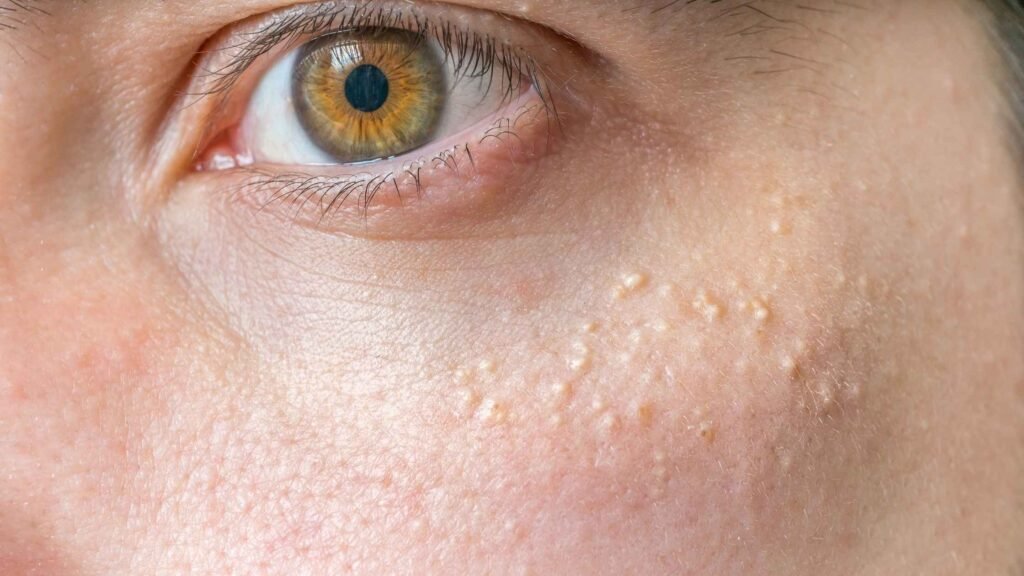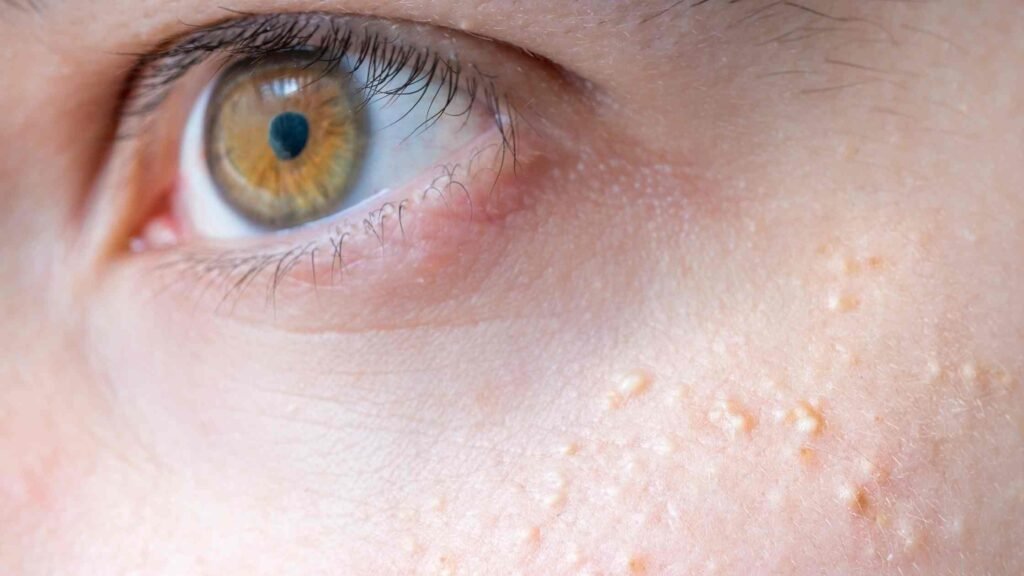Are you noticing small white bumps on your skin more often- especially on your nose, chin, or cheeks? Those are called milia. Milia can also appear elsewhere, and usually, they are grouped. In most cases, milia bumps disappear within a few months. But if they do not, or if you have been experiencing the same skin problem for quite a long time now- you need to give thought to taking the necessary steps to treat the skin condition.
Though there is no medical reason to remove milia as they are harmless, those white or yellow bumps are associated with discomfort to some extent. Therefore it is better to remove them manually by seeing a dermatologist and using products that may also help.
Milia occurs when dead skin cells get trapped under the skin. And there are different types of milia bumps. In this article, we will explain everything you need to know about milia bumps, including how they occur, what to do when such bumps appear on your face, and the safest ways to get rid of them.
Read this article till the end.
Read more about How To Reduce Body Heat Pimples

What Are Milia?
Milia are cyst-like small and white bumps that typically appear on cheeks and chin. These cysts appear in clusters. When dead skin cells or keratin become trapped beneath the skin’s surface, milia can occur. Keratin is a potent protein typically found in skin tissues, nail cells, and hair. People of all ethnicities or ages can have milia. Therefore milia is not a skin disorder in newborns alone. However, the risk of accumulating milia in newborns is higher than in adults.
What Are The Different Types Of Milia?

The types of milia are classified based on at which age the cysts are occurring or what are the causes behind the development of those cysts. The types of milia fall into primary and secondary categories. When the milia on your skin are formed from entrapping keratin, they are called primary milia. This type of milia is usually found on the face of adults and infants. On the other hand, secondary milia are similar by appearance, but they are developed after something has clogged the pores on the skin’s surface after an injury, burn, or blistering.
Read more about Best Way To Get Rid Of Blind Pimple
Neonatal milia
This is the primary milia that develop in newborns. In general neonatal milia clear within a few weeks. The cysts in this type of milia typically appear on the scalp, face, and upper torso. According to doctors, more than 40% of newborn babies can have these milia.
Milia in older children and adults
In older children and adults, milia can appear around the eyelids, forehead, or genitalia. This type of milia is also primary that disappears in a few weeks or sometimes might last several months.
Juvenile milia
Sometimes a few genetic disorders can lead to juvenile milia including:
· Pachyonychia congenita
· Gardner’s syndrome
· Nevoid basal cell carcinoma syndrome
Multiple eruptive milia
This type of milia may appear on the face, torso, and upper arms and consist of itchy skin areas. Someone affected by this type of milia may experience cysts appearing over time.
Milia en plaque
This skin condition is associated with autoimmune or genetic disorders. This type of milia affects the cheeks, eyelids, and ears. The cysts in this milia can be of different diameters, and they can primarily be seen in middle-aged women alongside adults and children of any age and sex.
Traumatic milia
In traumatic milia, the cysts occur where the skin is injured. For example, traumatic milia may occur if the skin was severely burnt before or had rashes. The cysts in this milia are very irritated with red edges and white centres.
Drugs or products cause milia.
Using steroid creams often leads to milia occurring on the skin, mainly where the cream is applied. However, this is more like a side effect.
There are many ingredients present in makeup products that cause milia in some people. And people who are very prone to milia must avoid ingredients like:
· Paraffin oil
· Petroleum oil
· Liquid paraffin
· Petrolatum liquid
Though all these ingredients are mineral oils, they may cause milia.
How The Doctor Diagnoses Milia?

Milia on the skin are visible; therefore, a dermatologist or medical aesthetician examines the skin to determine if the cysts on your face are milia. In rare cases, the doctors suggest skin lesion biopsies.
How To Get Rid Of Milia Bumps?
There are two different modalities to treat and eliminate milia bumps- home remedies and medical treatments.
Home remedies for milia
In most cases, milia disappear on their own within a few days or months. However, there are several home remedies to help you get rid of milia even faster. Though no specific remedy has been proven to be the most effective in removing milia quickly, the treatments we mention below are mostly low-risk and worth a try.
Rosewater
Rose petals are a beneficial ingredient that can be advantageous for our skin in many ways. Besides making our cheeks rosy, rosewater can also treat milia. Rosewater is widely available in the market and contains rose oil with anti-inflammatory properties. Because of this property, rosewater is one of the best home remedies you can help to get rid of milia. You can use just a few drops of rosewater on the affected area. Apply rosewater at least twice a day for better results.
Manuka honey
Manuka honey is unlike the regular honey we eat or apply to the skin. Manuka honey is better due to its enrichment of antibacterial properties. Manuka honey is darker than regular honey and thick in consistency. This honey comes directly from the manuka plant and is enriched with antimicrobial, anti-inflammatory, and antibacterial properties that help eliminate milia bumps. Moreover, manuka honey is also known for preventing microbial infections. You can take a spoonful of manuka honey and apply a layer to the affected skin. Now leave it for 30 minutes and rinse it off with warm water.
Sugar and lemon scrub
Sugar and lemon scrub is a great exfoliator and a potent alternative to market-based exfoliators. This exfoliator helps you get rid of skin pores and dead skin cells. Sugar is beneficial for scrubbing, and therefore, it is a natural remedy you can follow to treat milia at home. Sugar and lemon together remove dead skin cells and toxins from the skin. To make this scrub, take one tablespoon of sugar and mix it with a few drops of lemon. Apply the mixture to your face and massage gently for 15 to 20 minutes. Since this scrub is made of all-natural ingredients, there is no harm in using it daily. After using this scrub for a week, you will notice your milia bumps are reducing.
Coconut oil
Yet another ingredient is available in almost every household, and it’s pretty beneficial to treat different skin conditions. Coconut oil is very good at treating milia. You must apply a few drops of coconut oil to the affected area and gently massage it on your face. The antibacterial properties of coconut oil reduce the scars on your face. If you have hard milia on your face, the coconut oil can smoothen it and make removing those bumps easier. For better results, apply coconut oil before bed and wash it off in the morning.
Vitamin A foods
Foods that are rich in vitamin A are highly beneficial for our skin. According to the researchers, different sources of vitamin A are available in the market, and we need to add them to our diet to remove milia from our skin effectively. Vitamin A removes dead skin cells and maintains good skin health. Almonds, avocados, and carrots are some of the most significant sources of vitamin A, and one can consume up to 800 mcg of vitamin A daily.
Potato
Potato is another home remedy that can help you get rid of milia. Potato is a cleaning component for the skin as it contains a high amount of starch that prevents and treats various skin conditions, including white bumps on our face. To use potato first, you need to grind one potato and extract its juice. Now keep the juice in the fridge for a while. Next, dip a cotton pad into the potato juice and apply it to the affected area of your face. Once it is dried, you can wash it off with warm or cold water. For best results, you can do it twice a day.
Sandalwood powder
Sandalwood powder is an excellent remedy for skin health improvement. Mix one tablespoon of sandalwood powder with adequate water to make it a thick mixture. You can also use rosewater instead of regular water for better and quick results. Apply the pack to your face and affected areas and massage gently in a circular motion. Let it dry for a few minutes, and then wash your face with warm water. Using sandalwood powder at least twice a day brings you better results.
Aloe Vera gel
Aloe Vera gel has many benefits, from healing sunburns to treating milia bumps. Aloe Vera gel protects our chapped lips, elbows, and even skin. Therefore it is in your best interest to include Aloe Vera gel in your daily beauty regime to have the most of this medicinal plant. Moreover, aloe Vera has antioxidants and anti-inflammatory properties that help treat milia while soothing and cooling the affected areas. There are many aloe Vera gels available in the market. But if you want fresh aloe Vera gel, remove the leafy layer and extract the inner gel to apply to your skin.
Steam
Steaming is not only suggested when you have health concerns like a cold or flu. But steaming is also necessary to rejuvenate and soothe our skin. Steam opens up the clogged pores on our face and helps avoid the build-up of toxins and dirt. Take a cloth and cover your head while streaming your face. The hot steam helps heal the skin from underneath, and you must do this for at least 10 minutes every day to get relieved from milia. You can also scrub your face after streaming for better results.
Castor oil
Castor oil is known for its anti-inflammatory properties that benefit our skin. You can apply a little Castor oil to the affected area to get rid of million naturally. But before applying Castor oil, you must thoroughly clean your face with water and then dry it up. Now massage the oil on the affected area and let it stay for at least 30 minutes before you wash it off with water and wipe with a dry towel. You can repeat this process daily to get quick results.
Medical Treatments For Milia Bumps
If, even after trying as many home remedies as possible, your skin concern is not going away, you need to see a doctor. Your doctor might suggest specific clinical treatments to remove milia, including:
· Cryotherapy: It is an uncommon procedure in which dermatologists freeze off the milia with liquid nitrogen. This process can be followed by swelling or blistering that disappears within a few days after the treatment. However, cryotherapy is not suggested if the milia on your face are closest to the eyes.
· Minocycline: Minocycline is also known for treating acne and other skin infections. Minocycline is known for its potency in killing bacteria and reducing inflammation. It also has anti-inflammatory properties that reduce redness and swelling caused by milia. Your doctor might suggest a topical application of minocycline.
· Curettage: It is a less popular practice and is a form of electrosurgery. In this process, your dermatologist scrapes off the milia and then seals the skin with a hot wire.
· Laser Ablation: In this treatment, a small laser focuses on the milia, opens the cysts, and extracts the keratin that builds up underneath the skin.
· De-Roofing: In this procedure, a sterilized needle removes the milia from under your eyes.
Products You Can Try To Treat Milia Bumps
Apart from the medical treatments and home remedies, a few products are available over the counter to treat milia bumps. But make sure that you read the label of those products and ensure they are safe to use under your eyes. The area under our eyes is susceptible; therefore, little attention to the ingredients can be invaluable.
You can try topical alpha hydroxy acids such as lactic acid and glycolic acid to promote healthy skin. And alpha hydroxy acids are available in ingredients like:
· Face masks
· Skin peels
· Astringents
· Face toners
Salicylic acid is also known for peeling dead skin cells away from our face and releasing keratin trapped between skin layers. In many exfoliating creams and cleansers, salicylic acid can be found. You can also buy over-the-counter retinoid creams to encourage cell turnover and reduce the stickiness of the pores.
Can I Apply Makeup With Milia On My Face?
Milia bumps are not a very severe skin disorder; therefore, if you may wish to cover the bumps with a concealer or foundation, you can. But make sure that you are not applying any hypoallergenic makeup products that can clog your pores. When you apply a cumbersome layer of makeup on your skin with milia, your skin refrains from going through the natural process of shedding skin cells. And once your skin pores are clogged, they can trap keratin further and cause more problems. We suggest applying powder-based makeup products on areas affected by milia to make the milia less noticeable without harming your skin further.
Can Milia Be Prevented?
Though it is impossible to prevent milia in newborns, in adults, milia associated with other skin conditions and injuries can be prevented. Here are a few tips to prevent milia, including:
· Avoiding applying thick creams or oil-based products
· Exfoliating the skin twice a week
· Avoiding overexposure to the sun
Sometimes a wrongly done chemical peel treatment can lead to milia. And therefore, it is necessary to apply topical retinoids after the procedure.
Conclusion
Milia carry very low risks. But it is essential to diagnose milia correctly as they are very easily confused with other skin conditions, including miliaria and comedones. If not appropriately treated, milia can cause long-term problems. Therefore if milia are your current skin concern, it is better to discuss them with a doctor. In most cases, the milia problem can be resolved within a few weeks of treatment. Milia bumps disappear naturally in newborns and children. But if they do not disappear within a few weeks, your doctor will suggest specific medical treatments.
